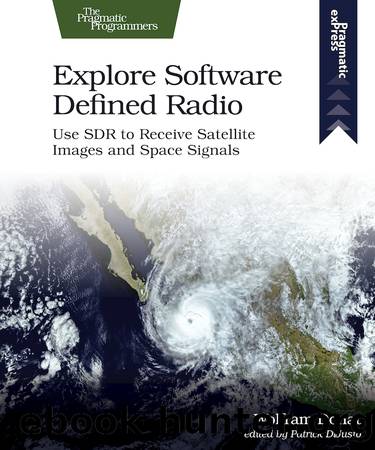Explore Software Defined Radio by Wolfram Donat

Author:Wolfram Donat [Wolfram Donat]
Language: eng
Format: epub
Publisher: Pragmatic Bookshelf
Published: 2021-01-21T16:00:00+00:00
You may notice that the length of the antenna is explicitly depicted in both figures; this is because in both cases, the length of the antenna poles has a specific relationship to the wavelength of the received signal. A monopole antenna will experience the best reception if the antenna is one-quarter the length of the signal wavelength. A dipole, being really nothing more than two monopoles stuck together, will get the best reception if the total length of the antenna (both monopoles measured together) is one-half the signalâs wavelength.
Obviously, the length requirement is not a hard-and-fast rule, otherwise the whip antenna on your car (or the one built into your windshield) would be able to pick up only one stationâthe one whose signal frequency matched the antennaâs length. Rather, it means that antenna performance will be optimized at a particular length, and if you are designing an antenna to pick up one particular signal, then taking this rule into account will be to your advantage. An interesting experiment for a budding antenna physicist would be to use a handheld FM radio with a variable-length antenna and see if changing the length of the antenna affects the reception of different local stations. Following the equations given earlier, a monopole antenna should be set to about 75 cm to best pick up an FM station transmitting at 100.1 MHz, and making it longer should optimize reception of lower-frequency broadcasts (99.9, for example). Meanwhile, making it shorter (remember, higher frequencies mean shorter wavelengths) should optimize receiving stations at 101.1 and above.
The final antenna shapes that weâll talk about are those tuned to circularly polarized signals. And what shape is used for that type of reception? Not surprisingly, it hearkens back to the series of antennas mounted circularly around a central mast I mentioned earlier, but in this case itâs more of a DNA shape: the helix antenna.
The simplest helix antenna is the monofilar helix in the image that follows. We donât want to get too deep into antenna physics, again, so just know that things like the radius of the turns, the distance between them, the total length of the antenna, and the pitch angle affect the reception power. At its core, however, the monofilar helix is just a monopole antenna like the whip antenna we discussed earlier, only with an omnidirectional radiation/reception pattern.
Download
This site does not store any files on its server. We only index and link to content provided by other sites. Please contact the content providers to delete copyright contents if any and email us, we'll remove relevant links or contents immediately.
Sass and Compass in Action by Wynn Netherland Nathan Weizenbaum Chris Eppstein Brandon Mathis(7397)
Grails in Action by Glen Smith Peter Ledbrook(7291)
Kotlin in Action by Dmitry Jemerov(4633)
Management Strategies for the Cloud Revolution: How Cloud Computing Is Transforming Business and Why You Can't Afford to Be Left Behind by Charles Babcock(4127)
The Age of Surveillance Capitalism by Shoshana Zuboff(3411)
Learn Windows PowerShell in a Month of Lunches by Don Jones(3236)
Mastering Azure Security by Mustafa Toroman and Tom Janetscheck(3011)
Mastering Python for Networking and Security by José Manuel Ortega(2936)
Blockchain Basics by Daniel Drescher(2883)
TCP IP by Todd Lammle(2633)
Microsoft 365 Identity and Services Exam Guide MS-100 by Aaron Guilmette(2538)
From CIA to APT: An Introduction to Cyber Security by Edward G. Amoroso & Matthew E. Amoroso(2478)
Hands-On Azure for Developers by Kamil Mrzyglod(2397)
React Native - Building Mobile Apps with JavaScript by Novick Vladimir(2335)
MCSA Windows Server 2016 Study Guide: Exam 70-740 by William Panek(2309)
The Social Psychology of Inequality by Unknown(2304)
The Art Of Deception by Kevin Mitnick(2292)
Configuring Windows Server Hybrid Advanced Services Exam Ref AZ-801 by Chris Gill(2288)
Azure Containers Explained by Wesley Haakman & Richard Hooper(2171)
